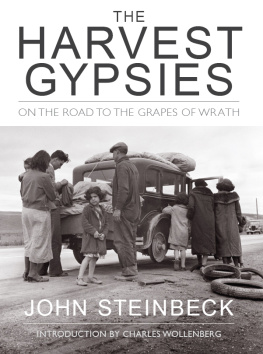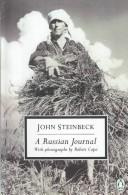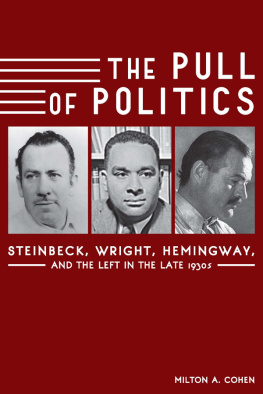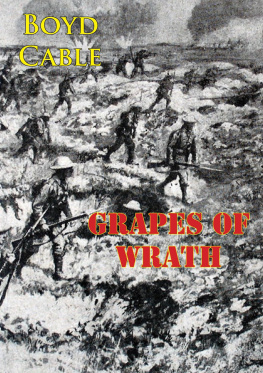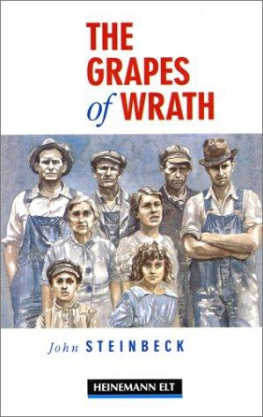Originally published in conjunction with Santa Clara University as part of the California Legacy series.
Copyright 1936 by The San Francisco News
Introduction copyright 1988 by Charles Wollenberg
All rights reserved. No portion of this work may be reproduced or transmitted in any form or by any means, electronic or mechanical, including photocopying and recording, or by any information storage or retrieval system, without permission in writing from Heyday.
Library of Congress Number: 88203891
ISBN: 978-1-890771-61-4
Photographs from the archives of the Farm Security Administration, reprinted courtesy of the Bancroft Library, University of California, Berkeley.
Cover Photo: Migrants on the road, February 1936, by Dorothea Lange
Cover Design: Ashley Ingram
Book Design: Sarah Levin
Orders, inquiries, and correspondence should be addressed to:
Heyday
P.O. Box 9145, Berkeley, CA 94709
(510) 549-3564, Fax (510) 549-1889
www.heydaybooks.com
INTRODUCTION
Charles Wollenberg
JOHN STEINBECK WROTE HIS MASTERPIECE, The Grapes of Wrath, in 1939, dedicating it to Carol, who willed this book, and to Tom, who lived it. Carol was Carol Henning Steinbeck, the authors wife; Tom was Tom Collins, manager of a federal migrant labor camp in the California Central Valley.
Steinbeck met Collins three years earlier, in 1936, shortly after The San Francisco News hired the author to write the series of articles gathered in this volume (originally published in the News, October 5-12, 1936). While accompanying Steinbeck on a tour of the Hoovervilles and Little Oklahomas of rural California, Collins provided him with much of the in-depth knowledge that makes this series compelling reading even fifty years after the fact. In the process, Tom Collins helped launch John Steinbeck on a personal and literary journey that would lead to the publication of The Grapes of Wrath.
Steinbeck received the News offer just as he was experiencing some long-delayed fame and fortune. Born in Salinas in 1902, he dreamed of becoming a writer while still at Salinas High School. He entered Stanford, but left in 1925 without a degree. In the years that followed he failed to make a living as a writer and was forced to take various short-term jobs and accept financial help from his family. By the early 1930s Steinbeck had matured into a big, rough-hewn man who masked his considerable sensitivities and insecurities behind a gruff, hard-drinking exterior.
With the publication of Tortilla Flat in 1935 his fortunes finally changed. In this funny, satirical novel about a group of down-and-out Mexican Americans Steinbeck turned to his roots in the Salinas Valley and Monterey. The book was immensely popular, although it was criticized by middle class Monterey burghers who objected to its off-beat depiction of their community, and, in later years, by Chicano activists who believed it played on unfavorable Latino stereotypes.
By the time Tortilla Flat was published, Steinbeck was at work on a far more serious book. He had met an organizer for the Communist Partys Cannery and Agricultural Workers Industrial Union, which in 1933 had launched an ambitious, though ultimately unsuccessful, attempt to organize California farm laborers. Steinbeck used the organizers experiences as the basis for In Dubious Battle, a grim story of a farm workers strike. The book was generally well-received, in spite of grower criticisms of its pro-worker perspective and radical unease at its less-than-flattering portrayal of Communist organizers. In Dubious Battle established John Steinbecks reputation as a serious writer with expertise on farm labor matters.
Steinbeck had met George West, an editor for The San Francisco News, some years earlier at the Carmel home of the noted radical journalist, Lincoln Steffens. After In Dubious Battle was published, West asked the writer to do a series on the dust bowl migration then sweeping through rural California. Steinbeck eagerly accepted and in the summer of 1936 began touring the states agricultural valleys in an old bakery truck. The federal Resettlement Administration, a New Deal agency that was beginning to establish camps for migrant workers, was looking for favorable publicity and assigned a staff member to accompany the author. It was at the agencys Weedpatch Camp at Arvin, in Kern County, that Steinbeck first encountered Tom Collins.
Collins was the model for the fictional Jim Rawley, manager of the government Wheatpatch Camp in The Grapes of Wrath. Ma Joad, matriarch of the Okie family whose experiences form the core of the novel, saw Rawley as a little man dressedall in white... a man with a thin, brown, lined face and merry eyes. He was lean as a picket. His white clean clothes were frayed at the seams. Steinbeck described the real-life Collins similarly, adding that he looked tired beyond sleepiness, the kind of tired that wont let you sleep even if you have time and a bed. Collins had previously been a teacher in Guam, the director of a school for delinquent boys, and a social worker for the Federal Transient Service, which dispensed emergency relief in the early Depression years. He joined the Resettlement Administration in 1935, managing the agencys first migrant camp at Marysville. When Steinbeck met him, he was in the process of establishing the Resettlement Administrations second facility at Arvin. JacksonBenson, Steinbecks major biographer, called Collins an idealist, a utopian reformer, a romantic, yet also a good administrator.
Steinbeck stayed at Weedpatch Camp for several days, talking to residents, attending camp committee meetings and dances, and watching Collins tactfully promote his concept of limited and guided self-government. Steinbeck and Collins travelled in the old bakery truck to nearby farms and ditch-side migrant settlements, and the author read the managers regular reports to the Resettlement Administrations regional office in San Francisco. The reports, which included social and cultural observations on migrant life and individual anecdotes sometimes told in Okie dialect, were extraordinary documents. The News had already published excerpts from them, and Steinbeck eventually mined them for material for The Grapes of Wrath. In 1936 he used them to get beneath the surface of migrant life, to understand the deep despair and hopelessness that poverty and homelessness had created.


